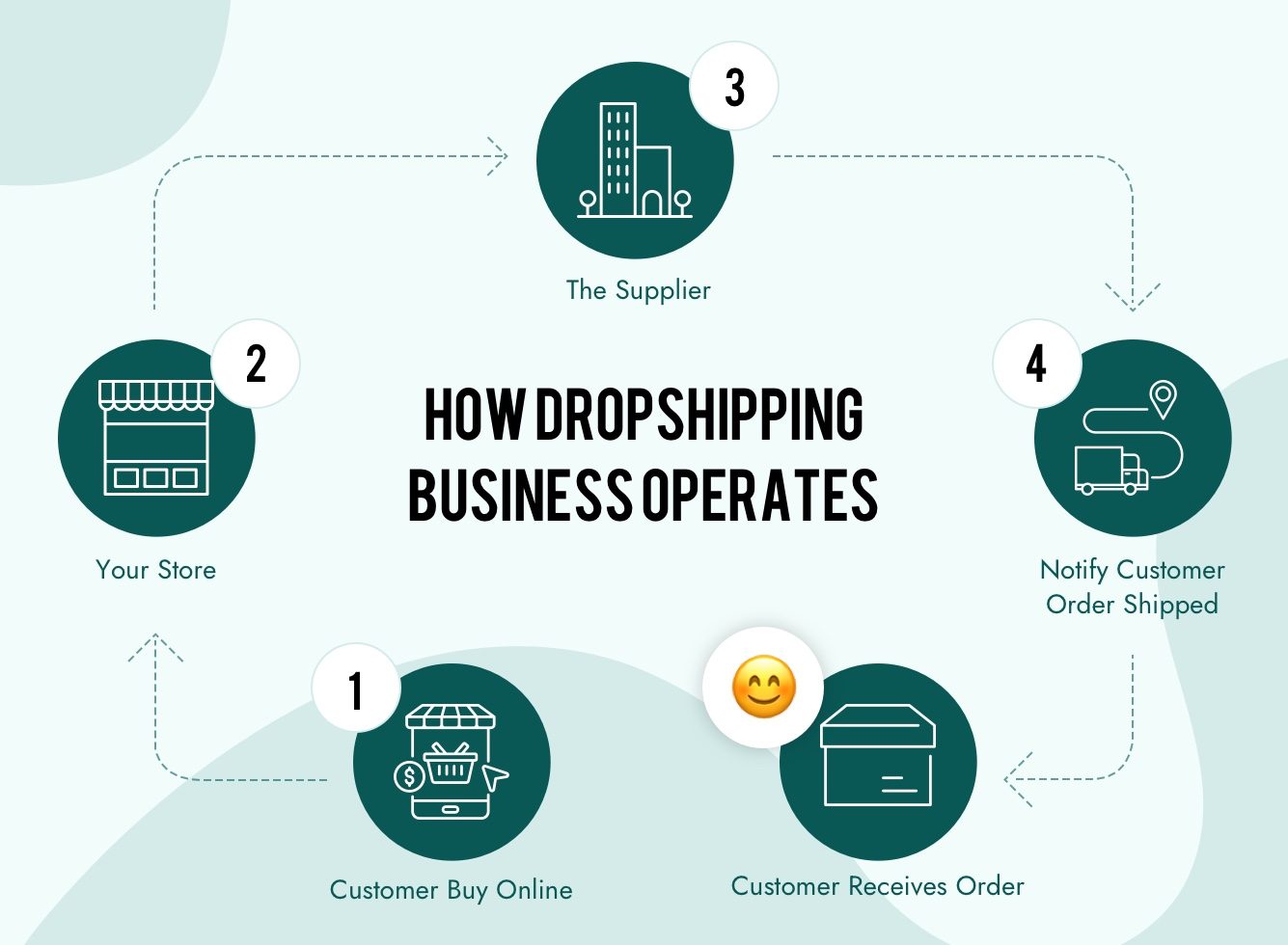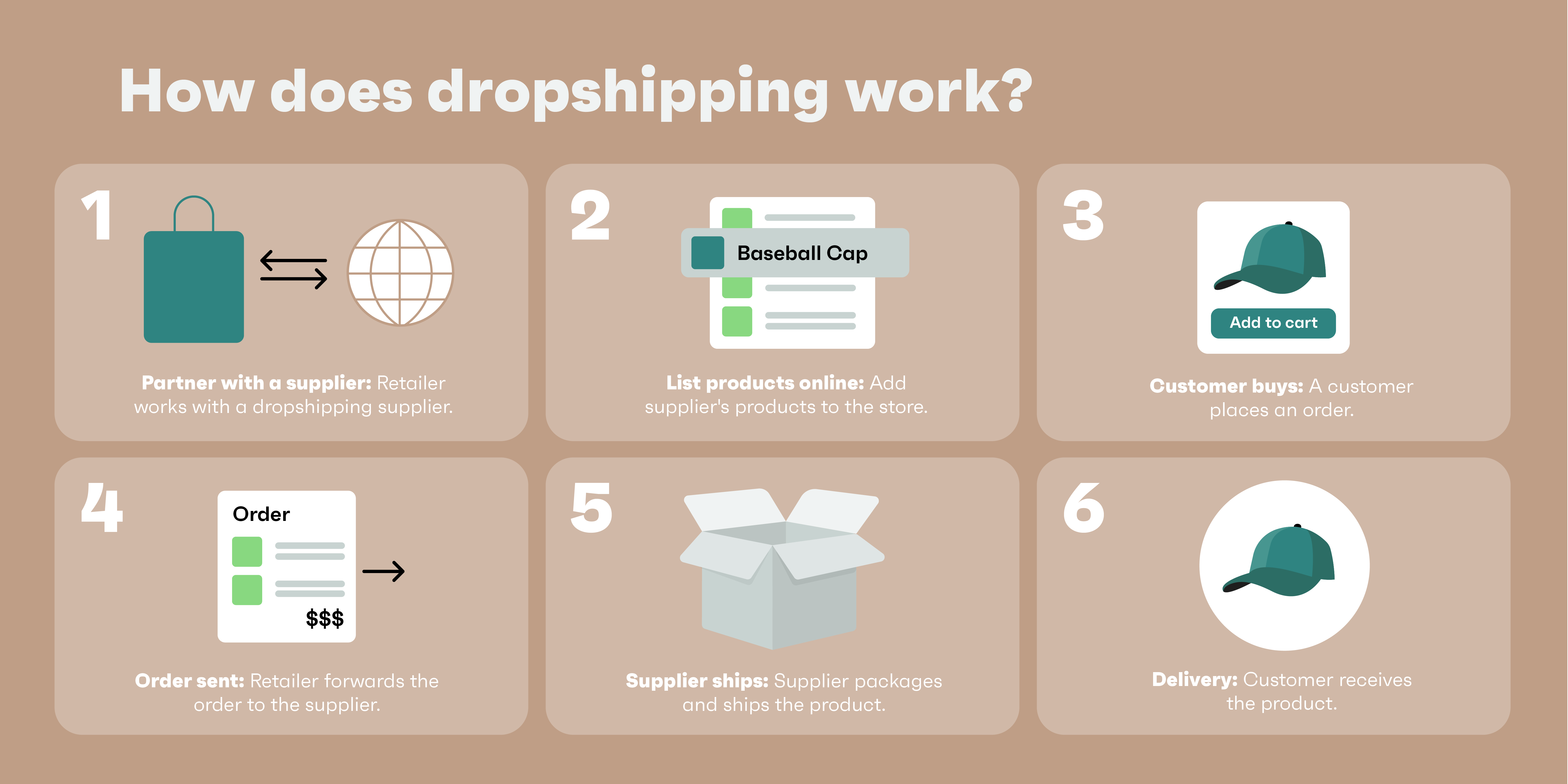Are you intrigued by the idea of running a business without holding any inventory? Dropshipping could be your ticket to entrepreneurial freedom, and Shopify is your perfect companion on this exciting adventure.
Imagine being able to offer a wide range of products without the hassle of managing stock or worrying about delivery logistics. Sounds appealing, right? As a beginner, navigating the world of dropshipping can be overwhelming, but this guide will simplify things for you.
You’ll learn how to set up your Shopify store, choose the right products, and start selling with confidence. We’ll break down each step so you can grasp the essentials without feeling lost. Plus, we’ll share insider tips to help you maximize your store’s potential and avoid common pitfalls. Get ready to discover how Shopify can transform your dropshipping aspirations into a thriving online business. Dive in, because your successful venture starts here!

Credit: www.shopify.com
Getting Started With Shopify
Shopify offers an easy path for beginners to start dropshipping. Set up your online store with simple tools. Choose products, customize your storefront, and manage orders effortlessly. Perfect for newcomers eager to dive into e-commerce.
Getting started with Shopify for your dropshipping venture can feel like an exciting adventure. As you dive into the world of e-commerce, Shopify provides a user-friendly platform that simplifies the process of launching your online store. Whether you’re new to dropshipping or just exploring your options, understanding the initial steps with Shopify is crucial for setting a strong foundation.Setting Up Your Shopify Account
Creating your Shopify account is your first step towards building your online store. Begin by visiting Shopify’s website and signing up with your email. You’ll get a 14-day free trial, which is perfect for testing the waters. Once you’re logged in, Shopify will guide you through the initial setup process. They ask simple questions about your business, such as what you’re selling and where you’re located. Answer honestly, as this helps tailor your dashboard to fit your needs. Personalize your store by choosing a name and adding your logo. This is where your brand starts to take shape. It’s like naming your new baby, so pick something memorable and reflective of your niche.Choosing The Right Shopify Plan
After your trial, you’ll need to choose a Shopify plan that suits your business goals. Shopify offers multiple plans, each designed for different levels of business growth and needs. Start with the Basic plan if you’re just testing the waters. It offers essential features without overwhelming you with options you may not need yet. As your business grows, you can always upgrade. Shopify makes it easy to transition to a plan with more features, like advanced analytics and additional staff accounts. Think about where you see your business in a year and choose accordingly. Are you a budget-conscious entrepreneur, or are you aiming for rapid growth? Your answer will guide you in selecting the best plan. Remember, your plan is a tool—make sure it serves your business strategy. Embarking on your Shopify journey is thrilling. Each decision, from account setup to plan selection, is a step closer to turning your dropshipping dreams into reality. What choices will shape your e-commerce story?Understanding Dropshipping
Shopify simplifies dropshipping for beginners by providing user-friendly tools to create an online store. Connect with suppliers and automate inventory management effortlessly. Start selling without handling products directly.
Understanding dropshipping is crucial for anyone starting an online store. It offers a unique way to sell products without managing inventory. This model allows you to focus on marketing and customer service. Let’s dive deeper into what dropshipping is and how Shopify simplifies the process.What Is Dropshipping?
Dropshipping is a retail model. You sell products without holding them in stock. When a customer orders, you purchase the item from a third party. This third party ships the product directly to the customer. You never handle the product yourself. This model reduces overhead costs and risks. It allows you to start an online store with minimal investment.Benefits Of Dropshipping With Shopify
Shopify is a popular choice for dropshipping. It provides a user-friendly platform. Setting up a store is simple and quick. Shopify offers various tools to manage products and orders efficiently. You can choose from many themes to design your store. This makes it easy to create a professional look without design skills. Shopify integrates with several dropshipping apps. These apps connect you to suppliers worldwide. They help automate the order process. This saves you time and reduces errors. Shopify’s customer support is available 24/7. You can get help whenever you need it. This support is crucial for beginners who might face challenges.Choosing Your Niche
Choosing the right niche is crucial for a successful dropshipping business on Shopify. It determines your product range and target market. A well-defined niche helps you stand out in the competitive e-commerce landscape. It allows you to focus your marketing efforts and build a strong brand identity. Here’s how to choose your niche effectively.
Researching Market Trends
Understanding current market trends is vital. Look for products that are in demand but not overly saturated. Use tools like Google Trends to spot emerging opportunities. Keep an eye on social media platforms for trending products. This research will help you identify potential niches with growth potential.
Identifying Your Target Audience
Knowing your audience is key to success. Determine who your ideal customers are. Consider their age, interests, and purchasing behavior. Use analytics tools to gather data on consumer preferences. This information will guide your niche selection and marketing strategies.
Sourcing Products
Shopify simplifies dropshipping for beginners with its user-friendly platform. Integrate with suppliers, select products, and start selling easily. Manage inventory, set prices, and track orders seamlessly with Shopify’s tools.
When starting a dropshipping business on Shopify, sourcing products is a crucial step. Your success largely depends on the quality and reliability of the products you choose. But how do you find products that will not only sell but also satisfy your customers? Let’s dive into some practical ways to source products effectively.Finding Reliable Suppliers
The foundation of any successful dropshipping business is built on finding trustworthy suppliers. Look for suppliers with a proven track record of quality and reliability. Websites like AliExpress and SaleHoo can be great starting points. When evaluating suppliers, check their reviews and ratings. A supplier with consistently high ratings is usually more dependable. Contact them directly to gauge their responsiveness and professionalism. Quick communication is key to resolving issues that may arise with orders. Think about attending trade shows or connecting with suppliers on platforms like LinkedIn. These connections can provide insights that go beyond online reviews. What’s your strategy for ensuring your supplier is reliable?Using Oberlo With Shopify
Oberlo is a popular app that seamlessly integrates with Shopify to simplify the product sourcing process. With Oberlo, you can add products to your Shopify store with just a few clicks. This tool connects directly to suppliers, ensuring that your product listings are always up-to-date. To get started, install Oberlo from the Shopify App Store. Once installed, browse through a wide range of products and select those that fit your niche. You can import products into your store effortlessly, saving you time and effort. Oberlo also automates order fulfillment, freeing you from manual processes. When a customer makes a purchase, the order details are sent directly to the supplier. This automation allows you to focus on marketing and growing your business. Have you considered how much time you could save by using tools like Oberlo?Building Your Online Store
Building your online store with Shopify can be straightforward and rewarding. It’s a crucial step in starting your dropshipping business. A well-designed storefront attracts and keeps customers. Let’s explore how to design your Shopify storefront and add products effectively.
Designing Your Shopify Storefront
Choose a theme that matches your brand. Shopify offers many free and paid themes. Pick a design that is simple and clear. Ensure your website is mobile-friendly. Many people shop using their phones. Use high-quality images for a professional look. Make your navigation easy to use. Customers should find what they want quickly. Customize your homepage with your logo and colors. This builds brand recognition and trust.
Adding Products And Descriptions
Add products that appeal to your target audience. Use clear, detailed product descriptions. Explain the benefits of each item. Include size, color, and material details. Use bullet points for easy reading. Add high-resolution images showing products from different angles. Use alt text for images to improve SEO. This helps your products appear in search results. Set competitive prices by researching market trends. Ensure your pricing covers costs and yields profit.

Credit: www.vsourz.com
Setting Up Payment And Shipping
Setting up payment and shipping on Shopify is crucial for a seamless dropshipping experience. These aspects ensure your customers can purchase products effortlessly and receive them on time. As a beginner, navigating these settings might seem daunting, but with a little guidance, you’ll find it’s quite manageable.
Configuring Payment Gateways
Choosing the right payment gateway is vital for your Shopify store. It’s how customers pay you, so reliability and security are key. Shopify supports multiple gateways like PayPal and Stripe, offering flexibility to cater to your audience’s preferences.
Consider where your customers are located. If you’re targeting a global audience, opt for gateways that support multiple currencies. This makes transactions smoother and broadens your customer base.
Don’t forget transaction fees. Compare the rates and choose a gateway that offers competitive pricing. Saving on fees can significantly impact your profit margins.
Establishing Shipping Policies
Shipping policies define how your products reach your customers. Start by determining your shipping zones. Are you shipping locally, nationally, or internationally? Knowing this helps in setting accurate shipping rates.
Offer various shipping options to cater to different needs. Some customers prefer speed, while others are okay waiting longer for a cheaper rate. Providing choices enhances customer satisfaction.
Think about offering free shipping for orders over a certain amount. It encourages larger purchases and can increase your average order value. Balancing cost and customer appeal is essential.
As you set up payment and shipping, think of your own online shopping experiences. What did you appreciate? What frustrated you? Use these insights to craft a user-friendly Shopify store. Are you ready to create a buying experience that keeps customers coming back?
Marketing Your Dropshipping Store
Shopify offers a simple platform for beginners to start a dropshipping store. Choose a niche, select products, and customize your store’s design. Use Shopify’s tools to manage inventory, process orders, and track sales easily.
Marketing your dropshipping store effectively can make the difference between a few sales and a booming business. As a beginner, understanding how to reach your audience is crucial. With the right marketing strategies, you can drive traffic and boost sales on your Shopify store. Let’s dive into some practical methods to help you succeed.Utilizing Social Media Marketing
Social media platforms are more than just places for sharing selfies and cat videos. They’re powerful tools for reaching potential customers. Consider using Facebook and Instagram to showcase your products with eye-catching posts. Create engaging content that tells a story about your products. Use Instagram Stories to share customer reviews or behind-the-scenes footage. Consistent posting keeps your store top-of-mind for followers. Don’t underestimate the power of social media ads. Start with a small budget to test which ads perform best. Facebook Ads Manager provides detailed targeting options to reach your ideal customers.Implementing Seo Strategies
Search Engine Optimization (SEO) helps your store appear in search engine results. This means more potential customers can find you when they search for products like yours. Start by using relevant keywords in your product titles and descriptions. Optimize your images by adding alt text. This is a simple way to improve your store’s SEO. Alt text helps search engines understand what your images are about. Consider creating a blog within your Shopify store. Write articles that answer common questions or offer tips related to your products. This not only boosts SEO but also positions you as an expert in your niche. Building a successful dropshipping store takes effort, but with the right marketing strategies, you’re well on your way. What marketing tactics have you found most effective for your store? Share your experiences and learn from others in the comments below!Managing Customer Service
Managing customer service in your Shopify dropshipping business is crucial. It builds trust and enhances customer experience. Good service can lead to repeat buyers and positive reviews. Let’s explore how to handle customer inquiries and manage returns efficiently.
Handling Customer Inquiries
Quick responses make customers feel valued. Use Shopify’s built-in tools for efficient communication. Consider integrating chat apps for real-time support. Templates for common questions can save time. Always keep your tone friendly and helpful. This builds rapport with your customers.
Managing Returns And Refunds
Clearly state your return policy on your Shopify store. Make it easy to find and understand. A simple policy reduces confusion. Use Shopify to track returns and process refunds promptly. Communicate with customers at every step. This transparency builds trust. Consider offering exchanges or store credit to retain customers. Always aim for a smooth and hassle-free process.
Analyzing Store Performance
Shopify simplifies dropshipping for beginners by offering easy-to-use tools. Set up your store, select products, and track sales effortlessly. Analyze store performance using Shopify’s built-in analytics to understand customer behavior and improve sales strategies.
Analyzing store performance is vital for your dropshipping success on Shopify. It helps you understand what works and what doesn’t. This insight allows you to make informed decisions. Let’s explore how to analyze store performance effectively.Tracking Sales And Traffic
Monitor sales and traffic closely. Use Shopify’s built-in analytics tools. They provide key metrics. Check daily sales figures. Look at the number of visitors. Compare these numbers over time. This shows patterns and trends. Use this data to identify peak sales periods. Also, note any sudden drops in traffic. These insights help refine your marketing efforts.Adjusting Strategies Based On Data
Data-driven decisions improve your store’s performance. Analyze which products sell best. Focus on these items. Look at sources of traffic. Are visitors coming from social media or search engines? Allocate resources to the most effective channels. If a strategy doesn’t work, change it. Test new approaches. Keep what increases sales and traffic. Regularly review and adjust your strategies. This ensures your dropshipping business thrives.
Credit: www.omnisend.com
Frequently Asked Questions
What Is Dropshipping On Shopify?
Dropshipping on Shopify involves selling products without holding inventory. You partner with suppliers who ship directly to customers. This business model reduces upfront costs and simplifies logistics, making it ideal for beginners. Shopify’s user-friendly platform helps you easily set up your store and integrate with various dropshipping apps.
How To Start Dropshipping On Shopify?
To start dropshipping on Shopify, create a Shopify account and set up your store. Choose a dropshipping app like Oberlo or Spocket to find products. Add products to your store and set pricing. Market your store through social media and SEO to attract customers and drive sales.
Which Shopify Plan Is Best For Dropshipping?
For dropshipping beginners, the Basic Shopify plan is recommended. It offers essential features like online store setup and product listings. As your business grows, consider upgrading to higher-tier plans for more advanced functionalities like reports and international selling. Evaluate your business needs to choose the best plan for you.
Can I Dropship Without Shopify Apps?
While possible, using Shopify apps streamlines your dropshipping process. Apps like Oberlo and Spocket automate product sourcing and order fulfillment. They save time, reduce errors, and offer valuable insights. Without apps, you’ll manually manage orders and suppliers, which can be time-consuming and less efficient for beginners.
Conclusion
Getting started with Shopify for dropshipping is simple and rewarding. The platform offers tools to help you grow your business easily. With patience and dedication, you can build a successful online store. Start small, learn daily, and adapt as you progress.
Remember, consistency is key in dropshipping. Keep your eyes on market trends and customer preferences. This will help you stay competitive. Enjoy the journey of setting up your store. Your hard work can lead to great results. Dive in and explore the potential of Shopify dropshipping today.
